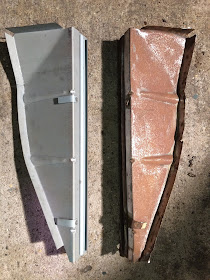Removing the rear valance basically involves locating and drilling out all the factory spot welds. There are quite a few down the side lips. Most need drilling, but a few had already broken off, having weakened from corrosion:
A few more spot welds inside the engine bay on the upper protruding taps and down the inner flange:
I then needed to grind a couple of small solid welds on the top edge of the lip:
Same procedure on the other side as you would expect:
And away it comes:
The valance hasn't faired well. The left hand side of the outer skin is misshapen from the rear end shunt (although this doesn't really show in the photos, but it is very obvious in real life). Additionally, the inner reinforcement section has a lot of corrosion and rust holes. It would take a lot of work to get this section anywhere near good again:
I will keep hold of it for reference, but ultimately replace it with a high quality BBT reproduction.
























